Abstract
We have characterized a C3a receptor on guinea-pig macrophages by 125I-C3a binding and functional responses. Scatchard analysis applied to the 125I-C3a binding to guinea-pig macrophages revealed the existence of two receptor classes; a high-affinity class with approximately 0.63 x 10(5) binding sites/cell with a Kd = 2.7 nM, and a relatively low-affinity class with approximately 1.2 x 10(5) binding sites/cell with a Kd = 51 nM. The binding of C3a to macrophages was totally blocked when there was an excess of C3a. C3a triggered a transient intracellular Ca2+ ([Ca2+]i) mobilization in macrophages, which was accompanied by homologous desensitization. C3a was also capable of generating O2- from macrophages. The C3a-induced Ca2+ response and O2- generation were not detected in the pertussis toxin-treated macrophages, suggesting that G proteins are coupled with the C3a receptors of macrophages. Although the C3a-induced O2- generation was inhibited by staurosporine, it was more resistant to staurosporine than phorbol 12-myristate-13-acetate (PMA)-induced O2- generation, suggesting that a protein kinase distinct from protein kinase C may be associated with the C3a receptor.
Full text
PDF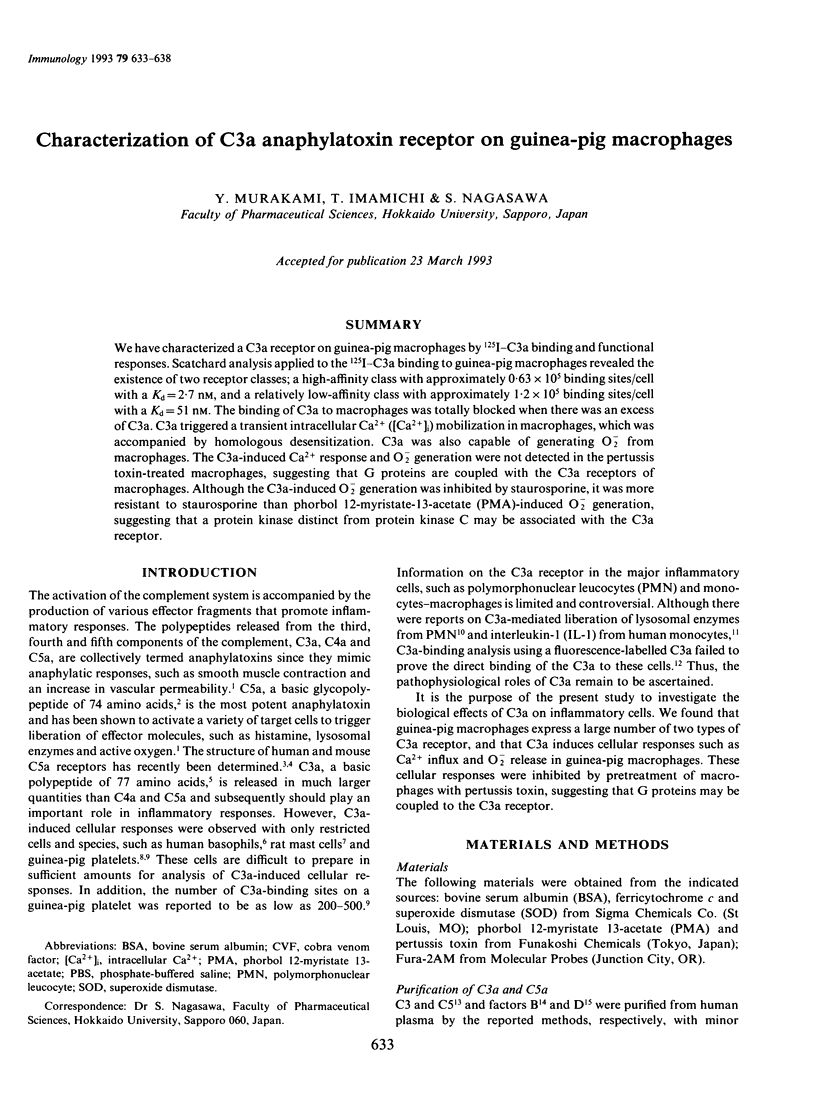
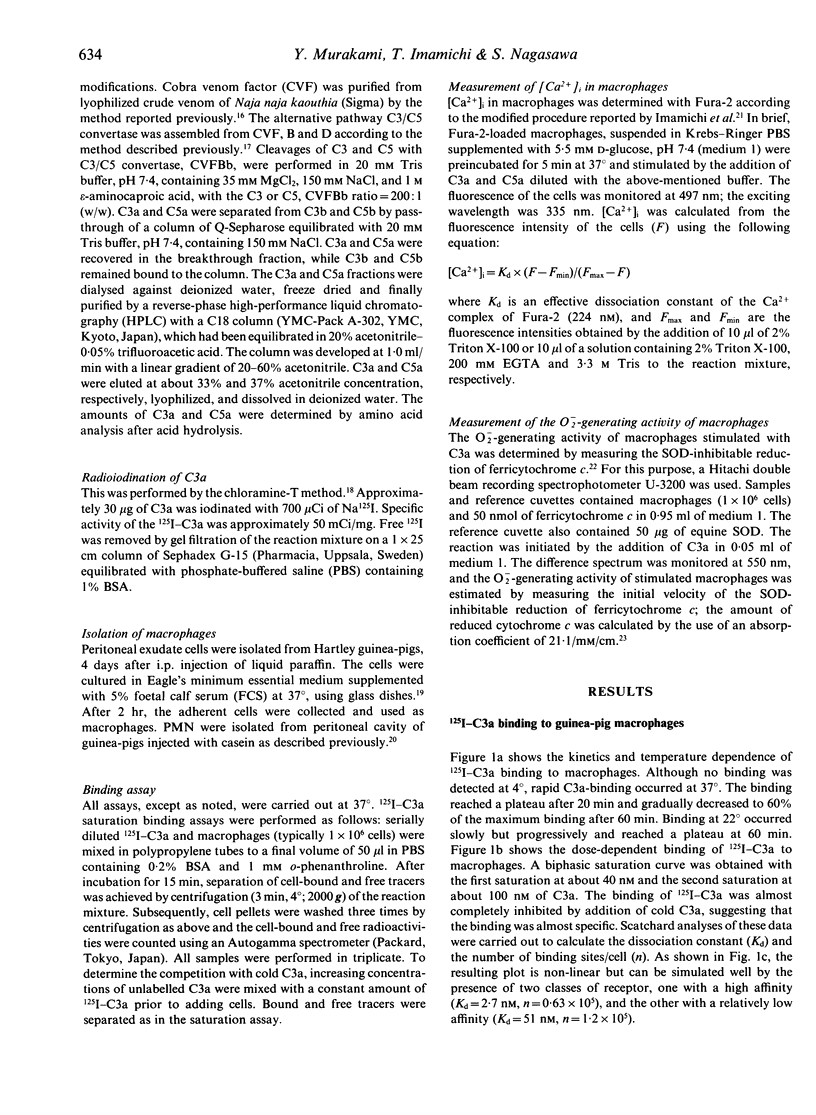
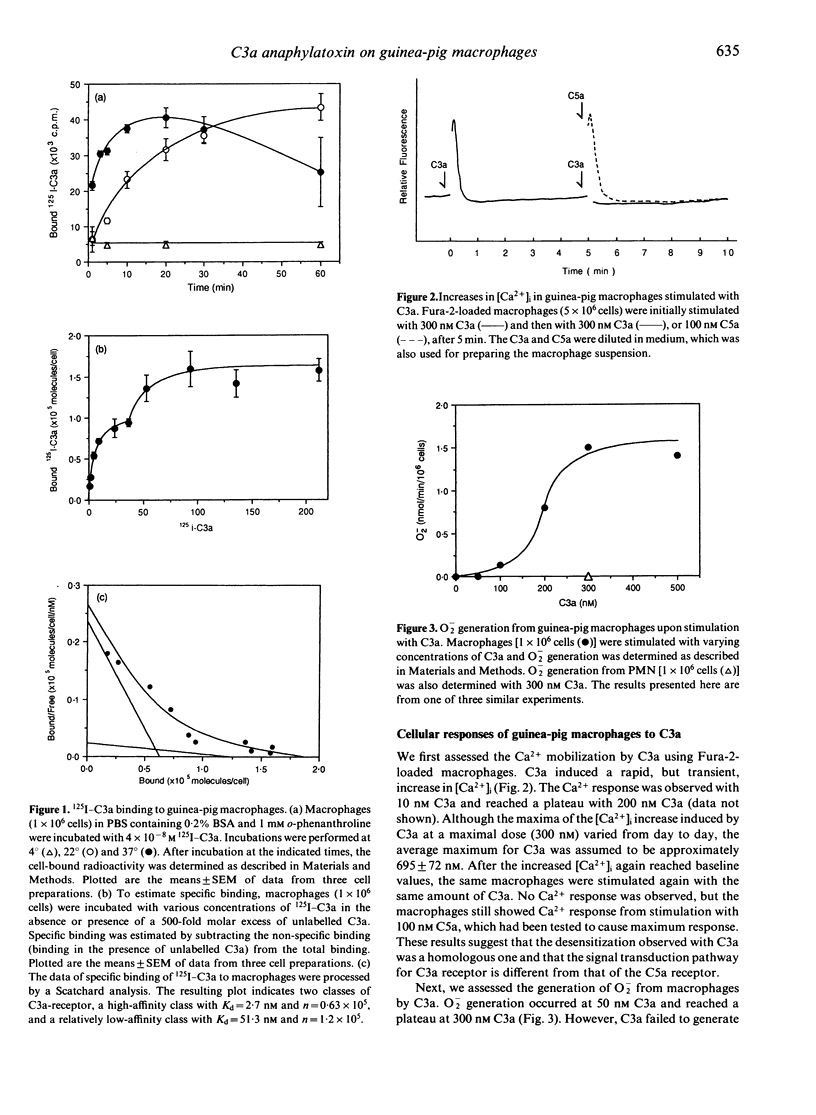
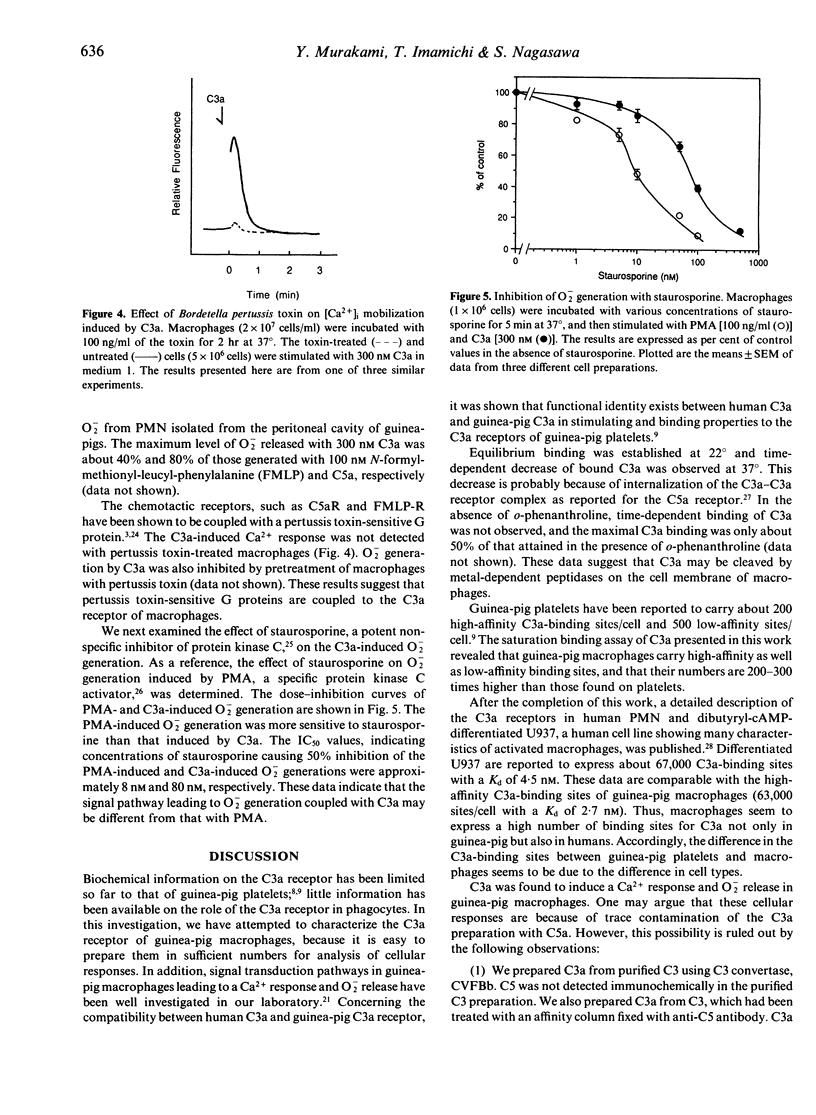
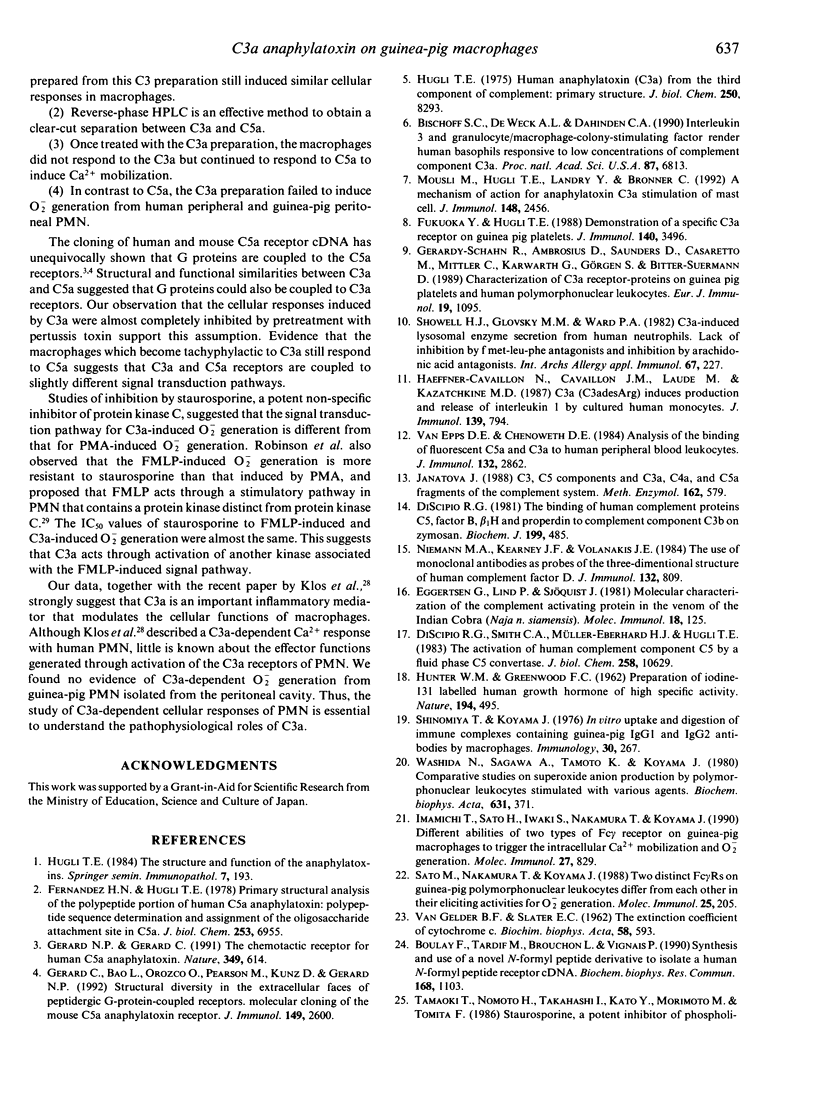
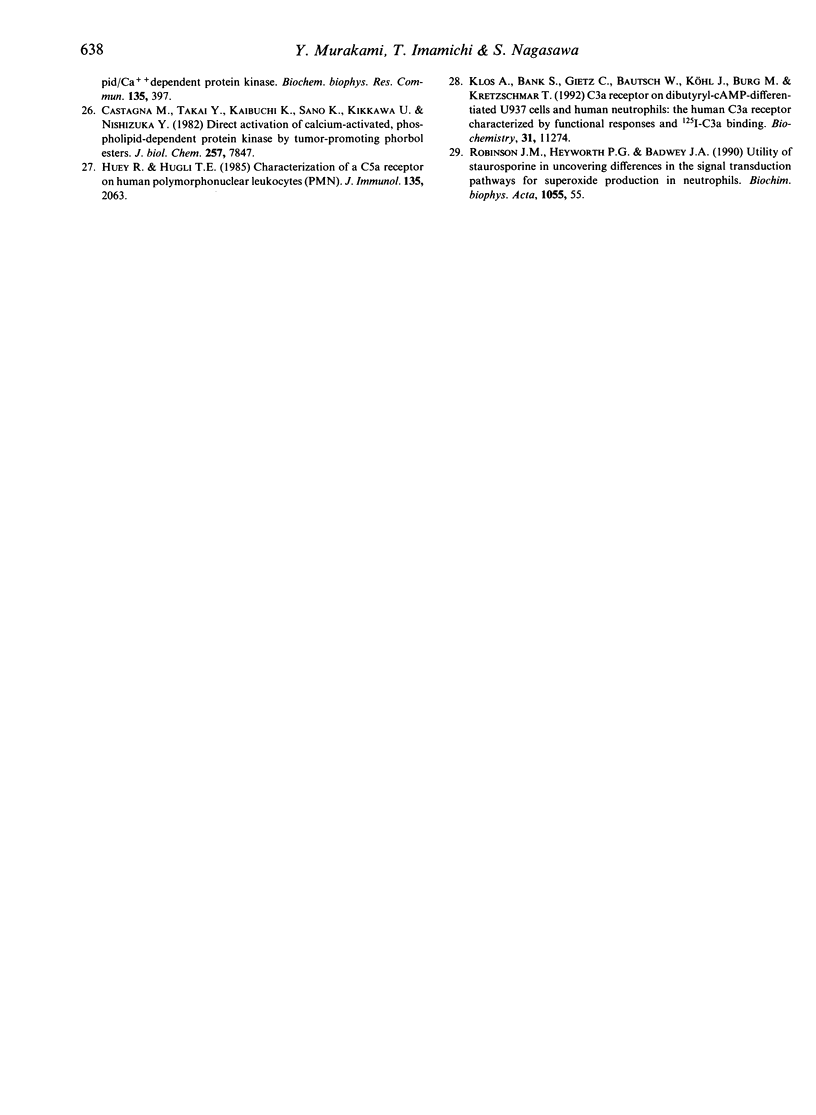
Selected References
These references are in PubMed. This may not be the complete list of references from this article.
- Bischoff S. C., de Weck A. L., Dahinden C. A. Interleukin 3 and granulocyte/macrophage-colony-stimulating factor render human basophils responsive to low concentrations of complement component C3a. Proc Natl Acad Sci U S A. 1990 Sep;87(17):6813–6817. doi: 10.1073/pnas.87.17.6813. [DOI] [PMC free article] [PubMed] [Google Scholar]
- Boulay F., Tardif M., Brouchon L., Vignais P. Synthesis and use of a novel N-formyl peptide derivative to isolate a human N-formyl peptide receptor cDNA. Biochem Biophys Res Commun. 1990 May 16;168(3):1103–1109. doi: 10.1016/0006-291x(90)91143-g. [DOI] [PubMed] [Google Scholar]
- Castagna M., Takai Y., Kaibuchi K., Sano K., Kikkawa U., Nishizuka Y. Direct activation of calcium-activated, phospholipid-dependent protein kinase by tumor-promoting phorbol esters. J Biol Chem. 1982 Jul 10;257(13):7847–7851. [PubMed] [Google Scholar]
- DiScipio R. G., Smith C. A., Muller-Eberhard H. J., Hugli T. E. The activation of human complement component C5 by a fluid phase C5 convertase. J Biol Chem. 1983 Sep 10;258(17):10629–10636. [PubMed] [Google Scholar]
- DiScipio R. G. The binding of human complement proteins C5, factor B, beta 1H and properdin to complement fragment C3b on zymosan. Biochem J. 1981 Dec 1;199(3):485–496. doi: 10.1042/bj1990485. [DOI] [PMC free article] [PubMed] [Google Scholar]
- Eggertsen G., Lind P., Sjöquist J. Molecular characterization of the complement activating protein in the venom of the Indian cobra (Naja N. siamensis). Mol Immunol. 1981 Feb;18(2):125–133. doi: 10.1016/0161-5890(81)90078-x. [DOI] [PubMed] [Google Scholar]
- Fernandez H. N., Hugli T. E. Primary structural analysis of the polypeptide portion of human C5a anaphylatoxin. Polypeptide sequence determination and assignment of the oligosaccharide attachment site in C5a. J Biol Chem. 1978 Oct 10;253(19):6955–6964. [PubMed] [Google Scholar]
- Fukuoka Y., Hugli T. E. Demonstration of a specific C3a receptor on guinea pig platelets. J Immunol. 1988 May 15;140(10):3496–3501. [PubMed] [Google Scholar]
- Gerard C., Bao L., Orozco O., Pearson M., Kunz D., Gerard N. P. Structural diversity in the extracellular faces of peptidergic G-protein-coupled receptors. Molecular cloning of the mouse C5a anaphylatoxin receptor. J Immunol. 1992 Oct 15;149(8):2600–2606. [PubMed] [Google Scholar]
- Gerard N. P., Gerard C. The chemotactic receptor for human C5a anaphylatoxin. Nature. 1991 Feb 14;349(6310):614–617. doi: 10.1038/349614a0. [DOI] [PubMed] [Google Scholar]
- Gerardy-Schahn R., Ambrosius D., Saunders D., Casaretto M., Mittler C., Karwarth G., Görgen S., Bitter-Suermann D. Characterization of C3a receptor-proteins on guinea pig platelets and human polymorphonuclear leukocytes. Eur J Immunol. 1989 Jun;19(6):1095–1102. doi: 10.1002/eji.1830190620. [DOI] [PubMed] [Google Scholar]
- HUNTER W. M., GREENWOOD F. C. Preparation of iodine-131 labelled human growth hormone of high specific activity. Nature. 1962 May 5;194:495–496. doi: 10.1038/194495a0. [DOI] [PubMed] [Google Scholar]
- Haeffner-Cavaillon N., Cavaillon J. M., Laude M., Kazatchkine M. D. C3a(C3adesArg) induces production and release of interleukin 1 by cultured human monocytes. J Immunol. 1987 Aug 1;139(3):794–799. [PubMed] [Google Scholar]
- Huey R., Hugli T. E. Characterization of a C5a receptor on human polymorphonuclear leukocytes (PMN). J Immunol. 1985 Sep;135(3):2063–2068. [PubMed] [Google Scholar]
- Hugli T. E. Human anaphylatoxin (C3a) from the third component of complement. Primary structure. J Biol Chem. 1975 Nov 10;250(21):8293–8301. [PubMed] [Google Scholar]
- Hugli T. E. Structure and function of the anaphylatoxins. Springer Semin Immunopathol. 1984;7(2-3):193–219. doi: 10.1007/BF01893020. [DOI] [PubMed] [Google Scholar]
- Imamichi T., Sato H., Iwaki S., Nakamura T., Koyama J. Different abilities of two types of Fc gamma receptor on guinea-pig macrophages to trigger the intracellular Ca2+ mobilization and O2- generation. Mol Immunol. 1990 Sep;27(9):829–838. doi: 10.1016/0161-5890(90)90148-s. [DOI] [PubMed] [Google Scholar]
- Janatova J. C3, C5 components and C3a, C4a, and C5a fragments of the complement system. Methods Enzymol. 1988;162:579–625. doi: 10.1016/0076-6879(88)62104-5. [DOI] [PubMed] [Google Scholar]
- Klos A., Bank S., Gietz C., Bautsch W., Köhl J., Burg M., Kretzschmar T. C3a receptor on dibutyryl-cAMP-differentiated U937 cells and human neutrophils: the human C3a receptor characterized by functional responses and 125I-C3a binding. Biochemistry. 1992 Nov 24;31(46):11274–11282. doi: 10.1021/bi00161a003. [DOI] [PubMed] [Google Scholar]
- Mousli M., Hugli T. E., Landry Y., Bronner C. A mechanism of action for anaphylatoxin C3a stimulation of mast cells. J Immunol. 1992 Apr 15;148(8):2456–2461. [PubMed] [Google Scholar]
- Niemann M. A., Kearney J. F., Volanakis J. E. The use of monoclonal antibodies as probes of the three-dimensional structure of human complement factor D. J Immunol. 1984 Feb;132(2):809–815. [PubMed] [Google Scholar]
- Robinson J. M., Heyworth P. G., Badwey J. A. Utility of staurosporine in uncovering differences in the signal transduction pathways for superoxide production in neutrophils. Biochim Biophys Acta. 1990 Oct 15;1055(1):55–62. doi: 10.1016/0167-4889(90)90090-z. [DOI] [PubMed] [Google Scholar]
- Sato M., Nakamura T., Koyama J. Two distinct Fc gamma Rs on guinea-pig polymorphonuclear leukocytes differ from each other in their eliciting activities for O2- generation. Mol Immunol. 1988 Feb;25(2):205–211. doi: 10.1016/0161-5890(88)90069-7. [DOI] [PubMed] [Google Scholar]
- Shinomiya T., Koyama J. In vitro uptake and digestion of immune complexes containing guinea-pig IgG1 and IgG2 antibodies by macrophages. Immunology. 1976 Feb;30(2):267–275. [PMC free article] [PubMed] [Google Scholar]
- Showell H. J., Glovsky M. M., Ward P. A. C3a-induced lysosomal enzyme secretion from human neutrophils: lack of inhibition by f met-leu-phe antagonists and inhibition by arachidonic acid antagonists. Int Arch Allergy Appl Immunol. 1982;67(3):227–232. doi: 10.1159/000233023. [DOI] [PubMed] [Google Scholar]
- Tamaoki T., Nomoto H., Takahashi I., Kato Y., Morimoto M., Tomita F. Staurosporine, a potent inhibitor of phospholipid/Ca++dependent protein kinase. Biochem Biophys Res Commun. 1986 Mar 13;135(2):397–402. doi: 10.1016/0006-291x(86)90008-2. [DOI] [PubMed] [Google Scholar]
- Washida N., Sagawa A., Tamoto K., Koyama J. Comparative studies on superoxide anion production by polymorphonuclear leukocytes stimulated with various agents. Biochim Biophys Acta. 1980 Aug 13;631(2):371–379. doi: 10.1016/0304-4165(80)90310-4. [DOI] [PubMed] [Google Scholar]
- van Epps D. E., Chenoweth D. E. Analysis of the binding of fluorescent C5a and C3a to human peripheral blood leukocytes. J Immunol. 1984 Jun;132(6):2862–2867. [PubMed] [Google Scholar]
- van GELDER B., SLATER E. C. The extinction coefficient of cytochrome c. Biochim Biophys Acta. 1962 Apr 23;58:593–595. doi: 10.1016/0006-3002(62)90073-2. [DOI] [PubMed] [Google Scholar]


